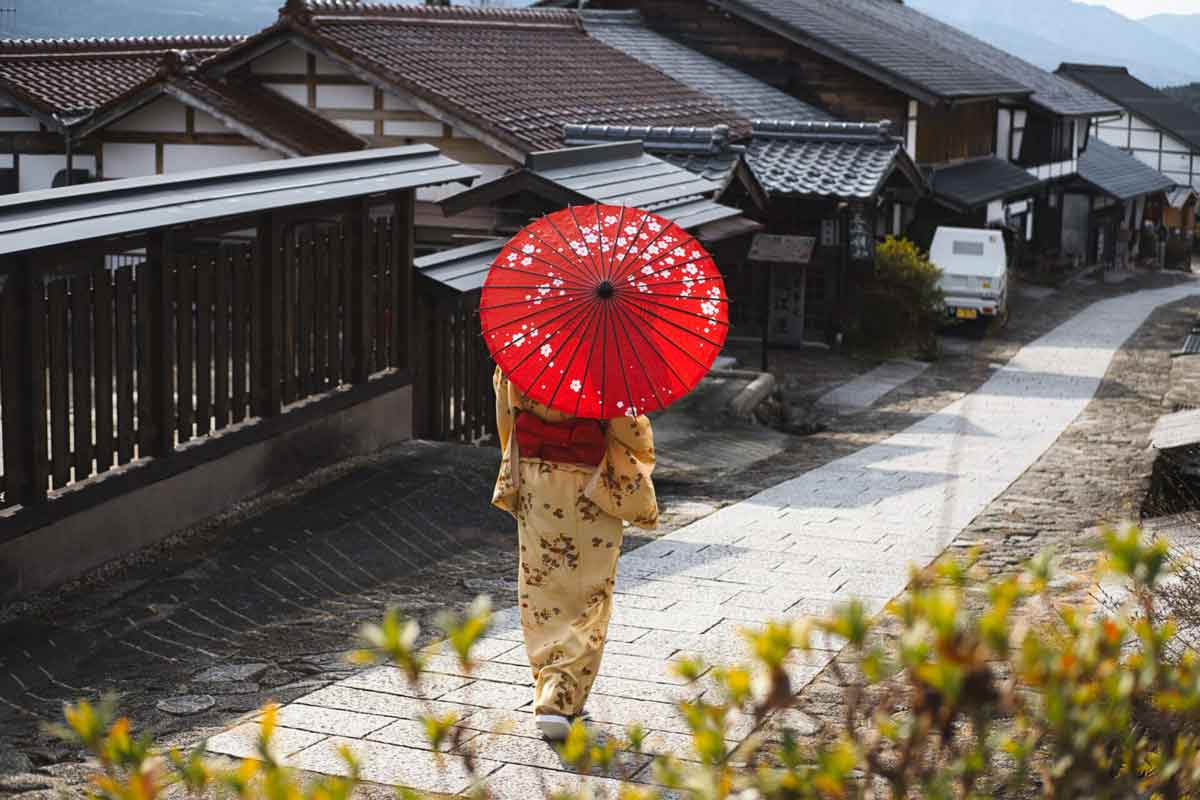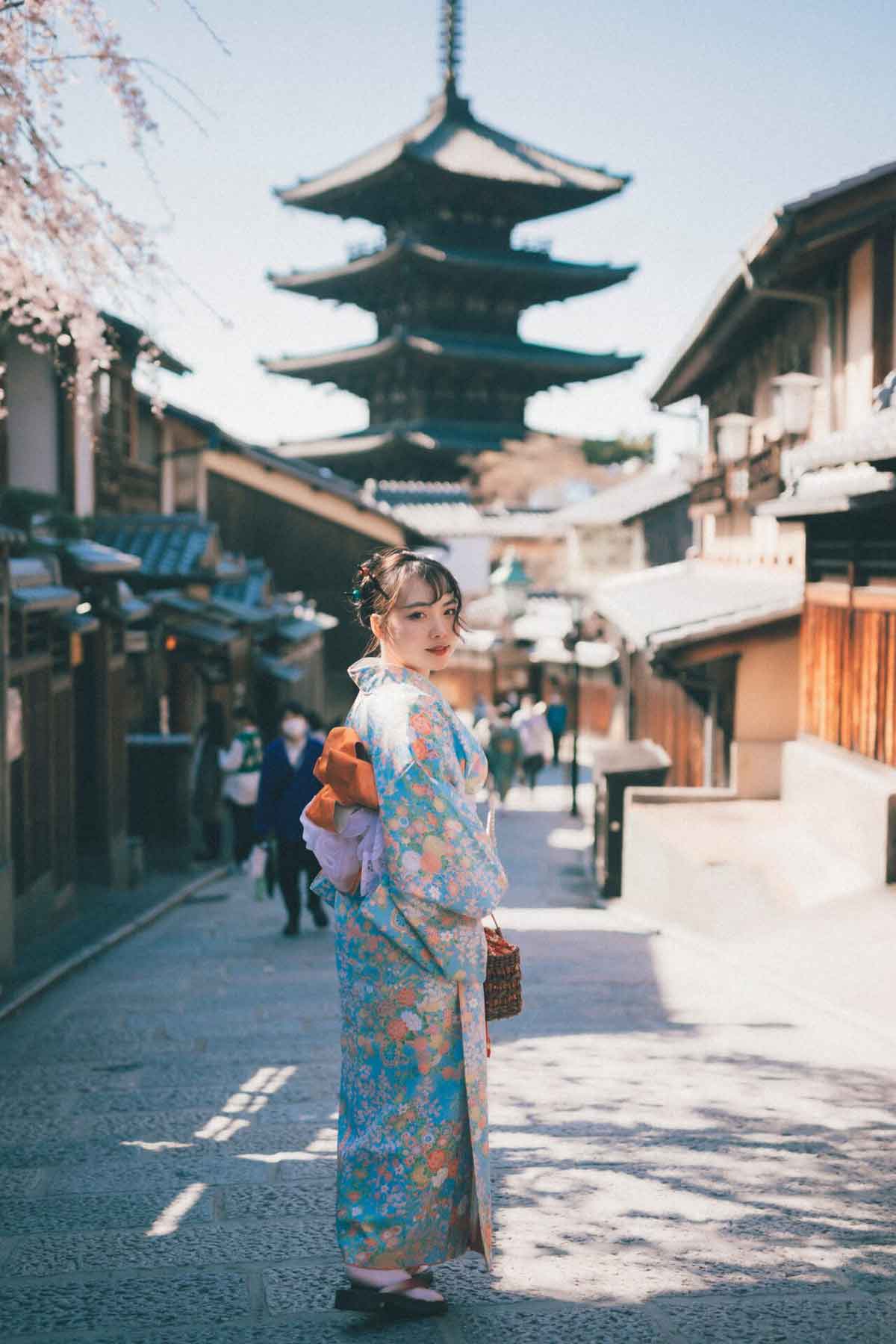
What is Yuzen?
Those who are familiar with kimono have heard of yuzen at least once. Yuzen is a dyeing method for patterns when dyeing cloth using rice, which has been indispensable to the Japanese people since ancient times. The name "yuzen" is said to have originated in the Edo period (1603-1867) from a Kyoto fan painter (Miyazaki Yuzenzai), who applied the then popular fan painting style to the pattern of kosode, and the dyeing process became widespread. The characteristics of the patterns are known as curvilinear and simplified animals, plants, vessels, and landscapes, etc. Natural dyes were used as raw materials for the colors, but in recent years chemical dyes have been used. The technique of preventing dyeing by gluing, which is said to be the most distinctive feature of yuzen dyeing, prevents neighboring colors from mixing by placing glue on the outline of the pattern, and it is said that this technique has developed a variety of colors and delicate patterns and improved expression.
The spread of yuzen dyeing is said to be due to the influence of the "Luxury Prohibition Ordinance," a law issued by the Edo shogunate prohibiting luxury goods at the time. This law prohibited the use of the deer shibori technique, which had been popular since the Nara period (710-794), and people's interest shifted to dyeing beautiful and gorgeous patterns. In the Meiji period (1868-1912), yuzen developed from natural dyes to imported chemical dyes, and from hand-drawn to copied yuzen using stencils, and further developed into yuzen that could be mass-produced. In recent years, in addition to traditional hand-drawn yuzen, machine dyeing and digital dyeing have been developed, and the charm of the traditional technique, which is demanded by a very limited number of people, is being overshadowed by the skeletonized yuzen-like quality demanded by a much larger number.
The spread of yuzen dyeing is said to be due to the influence of the "Luxury Prohibition Ordinance," a law issued by the Edo shogunate prohibiting luxury goods at the time. This law prohibited the use of the deer shibori technique, which had been popular since the Nara period (710-794), and people's interest shifted to dyeing beautiful and gorgeous patterns. In the Meiji period (1868-1912), yuzen developed from natural dyes to imported chemical dyes, and from hand-drawn to copied yuzen using stencils, and further developed into yuzen that could be mass-produced. In recent years, in addition to traditional hand-drawn yuzen, machine dyeing and digital dyeing have been developed, and the charm of the traditional technique, which is demanded by a very limited number of people, is being overshadowed by the skeletonized yuzen-like quality demanded by a much larger number.
About Yuzen Techniques

An interesting characteristic of yuzen is the craftsmanship of the technique. The first step of the process, the underpainting, is done by hand directly on the silk using plant-derived ink. Next comes the "itome" process, which is the most distinctive feature of yuzen. In order to prevent color bleeding when coloring the motif, a special tool is used to place a layer of rice glue on the outlines of the motif, a kind of masking. Drawing lines of a certain thickness requires skillful technique. After dyeing, a white itome-like line remains on the contour line, which is called itome. After itome, "color insertion," in which color is applied to the inside of the contour lines using a brush or a brush, takes place. Traditionally, naturally occurring dyes such as indigo and safflower were used, but today artificial chemical dyes are used. A certain amount of time is needed for one color to dry before the next color is added. After color insertion, the fabric is steamed to fix the dye by applying steam to the fabric before proceeding to the "jizome" process.
The " jizome " is the process of dyeing the entire fabric uniformly or with blurring. This is the process in which the widest area is dyed in hand-dyed yuzen, and it is a process that requires skilled techniques as well as color insertion, such as the need for subtle adjustment of color tones at the beginning and end of the dyeing process. After base-dyeing, the cloth is steamed to fix the dye again, and then the paste and dye on the cloth, also called yuzen-nagashi, is washed away by exposing it to a river. This process used to be done in natural rivers, but in recent years, it is often done in artificial rivers. Depending on the design, the details may be colored again or decorated with gold or platinum foil, which is called " Foil Placement".
Characteristics of Yuzen by Area

Yuzen has been handed down since the Genroku period in the Edo period (1688-1704), but in fact, even within the same Yuzen style, each region has a different flavor. The following is an introduction to the major production areas of yuzen dyeing and the differences between them.
Kyo Yuzen
Kyo yuzen, the origin of all yuzen, is said to have started in the Genroku period of the Edo period (1688-1704) with a fan painter, Miyazaki Yuzenzai. Kyo yuzen is characterized by the use of light, multi-colored patterns, delicately drawn patterns of flowers, birds, wind, and the moon, as well as traditional motifs. This is a very elegant and gorgeous yuzen with a touch of typical Kyo style.
Kaga Yuzen
Kaga Yuzen is a type of yuzen dyeing that began when the aforementioned Yuzenzai brought it to Kaga, and is produced in Kanazawa, Ishikawa Prefecture. Kaga yuzen is characterized by its unique colors, called Kaga goshiki (five colors of Kaga), as well as by the use of blurring, which is in contrast to Kyo yuzen, and by the " bug eaten" expression of ink dots on patterns such as tree leaves. In recent years, modern designs have also been introduced, and since the entire process is done by hand by a single craftsman, it can take from six months to a year to complete.
Tokyo Yuzen
Tokyo Yuzen is one of the three major types of Yuzen, along with Kyo and Kaga, and is said to have developed as a result of the spread of techniques and technology during the Edo period (1603-1868), when Ieyasu Tokugawa allowed painters and dyers from Kyoto to move to Edo (present Tokyo). Compared to Kyoto and Kaga, Tokyo yuzen is characterized by more subdued colors and a more stylish, urban feel that is unique to Tokyo.
About Yuzen and Japanese Dyeing
 As mentioned above, it is said that the technique of dyeing with starch paste, which is one of the most distinctive features of yuzen, was perfected before Yuzenzai. The "katagata" (pattern), which is used for dyeing, is also well known. Bingata dyeing, which was born in the Ryukyus, is also known as kata yuzen, in which dyeing is prevented by using a mold, and changes in pattern and color were mutually observed during exchanges with the mainland.
As mentioned above, it is said that the technique of dyeing with starch paste, which is one of the most distinctive features of yuzen, was perfected before Yuzenzai. The "katagata" (pattern), which is used for dyeing, is also well known. Bingata dyeing, which was born in the Ryukyus, is also known as kata yuzen, in which dyeing is prevented by using a mold, and changes in pattern and color were mutually observed during exchanges with the mainland.
Other dyeing methods include Kyo komon, which developed by incorporating kata yuzen techniques into Edo komon techniques, and huegami yuzen, in which designs are drawn and dyed directly with a paintbrush without the use of paste. Kekiage yuzen, in particular, is not as precise in composition as hon yuzen, but the unconventional free patterns and bold brush strokes show the artist's character rather than craftsmanship, and for this reason it is said to be rare, with few artists using this technique.
